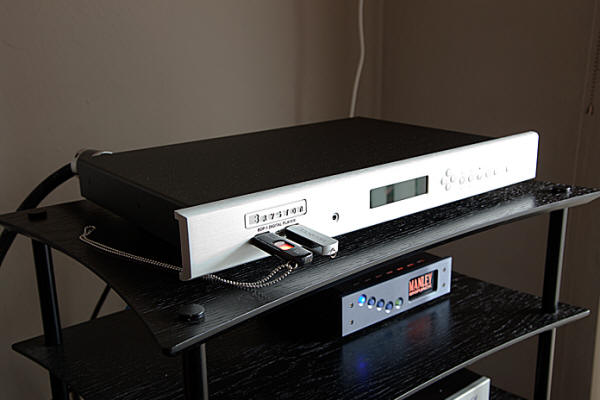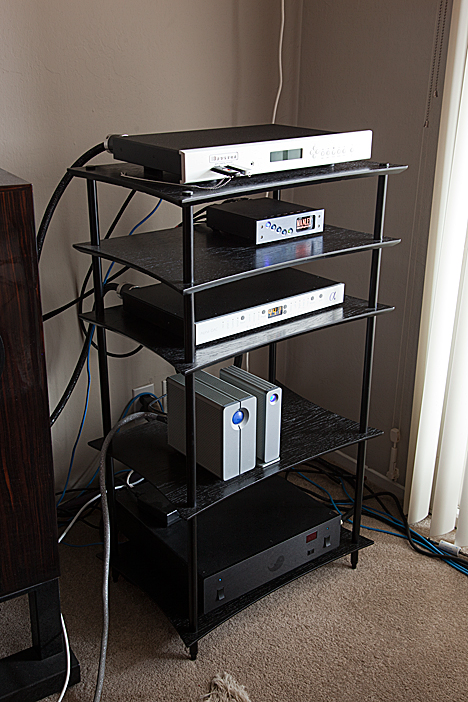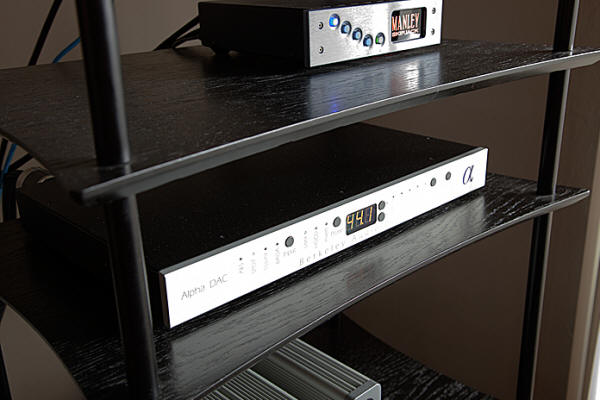|
You are reading the older HTML site
Positive Feedback ISSUE 56
The Bryston BDP-1: A Musical Squeezebox of Sound
"Mama's got a squeezebox
'Cause she's playing all night –The Who The Bryston BDP-1 is not exactly a squeezebox, but it is a source of beautiful sound; and paired with the right DAC, a storage device like a thumb drive or hard drive (Windows formatted), and some sort of control device (which, strictly speaking, is not necessary), you can have a complete digital music server without ever touching a Mac and without ever plugging your computer into your stereo system, sort of. You see the genius behind the BDP-1 is that it is a computer running the Linux operating system that has just been stripped down to do nothing but play music. It is true that you have to organize your music files in a certain way on a FAT32 or NTFS-formatted volume (i.e., a thumb/flash drive, a magnetic hard drive, a solid state drive, anything that uses a USB connection); but that's all right, because it's really easy to do. It goes something like this: 1. Drive 2. Main Music Directory/Folder
…and repeat until you've added as many artists, albums, and songs as you like. The Bryston is not particularly picky about this stuff and will play things in pretty much any order you setup; but the software, like their web interface, MPod and MPad (Apps for the iPod Touch or iPhone and iPad respectively) all need a little work, so you're helping them by organizing the music in the way that they expect… at which point you can create a playlist of just one album (or more); and off you go!
Basically, James Tanner got frustrated trying to create a digital music server and decided to build one from the bottom up himself; optimized for sound. He choose the Linux operating system because of its flexibility, simplicity, and the fact that it was so widely supported, plus he could strip out what he didn't want. He also chose a very good soundcard to do the S/PDIF conversion, and settled on a perfectly fine directory structure as a default. His company, Bryston, already had a very good 24/192 DAC on the market, and although I didn't use that, somewhat deliberately, I found the BDP-1 paired well with the Orb Jade 2 DAC (also capable of 24/192 performance) using the Locus Design Core S/PDIF cable. Now at this point I should probably go into a long discussion about the technology of the Bryston and measure its signal to noise ratio; but I think that plenty of people have done that and I want to discuss its sound subjectively. The BDP-1 has a very rich, very clean sound with ample bass and astonishingly low levels of distortion. In that sense, it reminded me of some products from Allen Perkins (the old RPM-1 and 2 turntables and more recently Spiral Groove) which also strive to have very low levels of distortion. It isn't until you hear such a low distortion system that you realize all the "fuzz" that you thought came from the dust on your stylus was actually coming from the noise in your electronics, or somewhere else. While I do think there is a certain finesse to my home-grown digital music server—and I was lucky enough to start with a Macintosh—it doesn't have the deep bass definition nor the strikingly low levels of distortion that I get from the BDP-1. The only area of complaint I have is that the software used to run all this, even MPad, leaves a little to be desired when you compare it to iTunes; and of course you can't insert Amarra. However, it is really nice to just load up some media with FLAC files—organized according to the outline above—plug it into the BDP-1, let it do a little recognition and start creating playlists on my iPad 2 that just run and run with music, everywhere up to 24/192 which—via the BDP-1—sound delicious.
One thing that is nice is that you don't need an expensive DAC to bring the best out of the BDP-1; the Orb Jade 2 sells for under $2K. However, if you have a more expensive DAC, I'm sure the BDP-1 would not be the limiting factor. Also, it's REALLY nice to have a component in your system that doesn't look like a computer. Many people are flocking to Mac Mini's as their digital music server computers; and they are supposed to sound very good. If you try really hard, you can kind of get it to look like it's an audio component; however, I still use a 17" MacBook Pro with 8GB of RAM and a 256GB SSD as my music computer, so it definitely looks like a laptop sitting on top of my Quadraspire stand. That may be a minor complaint; but aesthetics are important to me and after using the BDP-1, I got so used to remote controlling everything that I actually bought a copy of "Remote Desktop" from Apple to run my 17" MacBook Pro from 11" MacBook Air giving me much the same functionality I had when I ran the BDP-1. Now you can run the BDP-1 from its front panel; but it's awkward and you need a computer to create the music data anyway. So I don't think that that's an issue. Just remember if you're using a Macintosh you need to format the drive you plan to plug into the Bryston with the FAT32 file system, because as of this writing you can't load files created in the Macintosh's native format, a minor inconvenience.
I mentioned that I felt the Bryston would synergize with a more expensive, higher-resolution DAC than the Orb Jade 2, not that there's anything wrong with the latter; fortunately, my new reference DAC—which I purchased to replace my overly resolute dCS Debussy—arrived. Specifically, it is a Berkeley Audio Labs Alpha DAC, or "BADA". The combination of the BDP-1 and the BADA is strikingly neutral, and while I have a great fondness for my 17" MacBook Pro and Sonicweld Diverter, I have to confess the BDP-1 may be more accurate in terms of playing what is actually on the drive. It's certainly easier to set up. Playing John Ward: Consort Music for Five and Six Viols by Phantasm on Linn Records at 24/192, there was a striking sense of air and ambience around the instruments and the sense that the overtones of the strings could reach for the sky. Playing "The Girl From Ipanema" from the 24/96 copy of Getz/Gilberto, the voices had an almost Quad-like purity to them. What it revealed to me, is that the BDP-1 really plays it as it is, with no coloration, no hint of distortion, and no homogenization. Does it lack a slight sense of vinyl-like finesse that I get from my full-blown digital music server? Yes; but that fact that it could only improve with a $5000 DAC (the best DAC I've heard short of my Audio Note DAC 4.1 Balanced) with $5K+ of analog interconnects, only attests to the engineering acumen of Bryston and James Tanner. Well done.
Now lets talk a little about the software. First, it's not iTunes; but that's okay because it gets things done. Even the web-based application for managing music works very well, as long as you remember one thing: in iTunes, playlists are "add ons". In the Bryston software, they're the center of the world. Everything plays from a playlist, which you can construct and destroy interactively with helpful tools like buttons above the album contents that say "Add All [to Play List]". Once you have that sorted out, you can't go wrong. So what else can I say? The Bryston BDP-1 is a remarkable musical computer that just requires a S/PDIF cable and a DAC to bring you into age of computer-based music (OK, you need a flash drive or hard drive and some kind of computer to manage the music and remote control the Bryston; an iPhone, iPod Touch or iPad helps); but no matter how you look at it this is a remarkable device that gets that much closer to integrating the Internet into your home audio system and doing so with aplomb.
"Mama's got a squeezebox –The Who Kindest regards, Andy P. S. In order to optimally use the BDP-1, you will need a wireless router—not just an Internet modem—to both share the connection with the BDP-1 and your computer and to use portable devices for remote control; but everyone has one of those these days, even my nameless, non-audiophile girlfriend.
|




